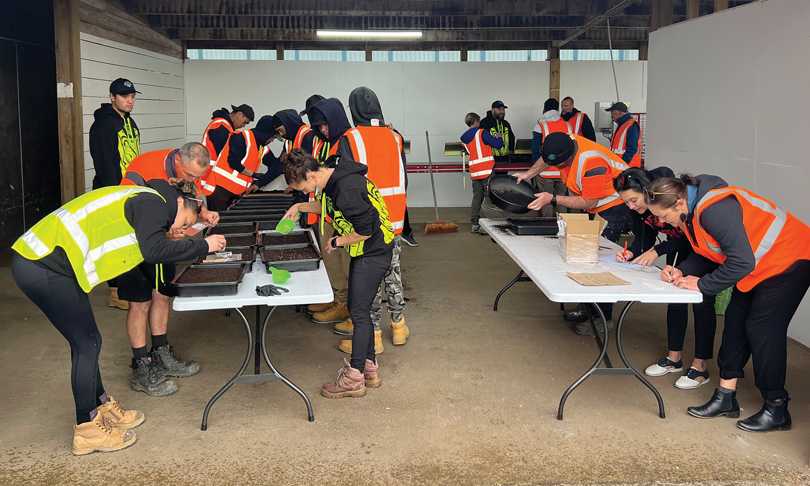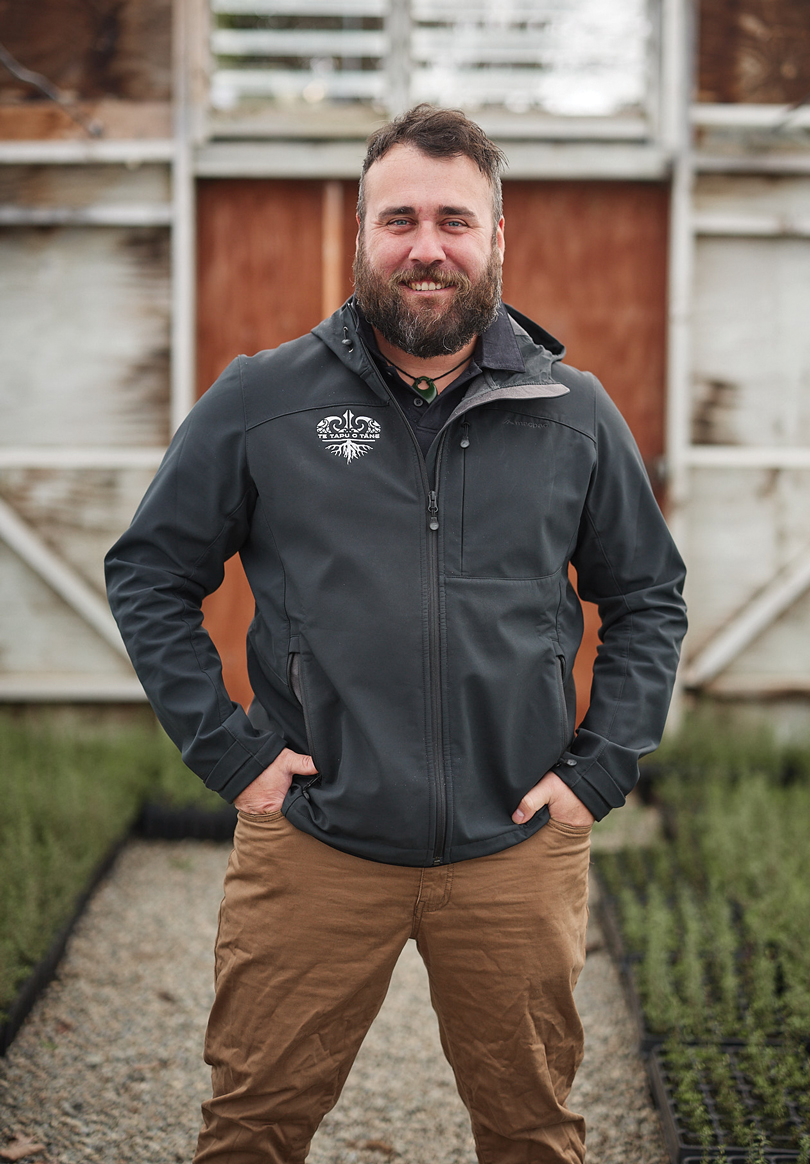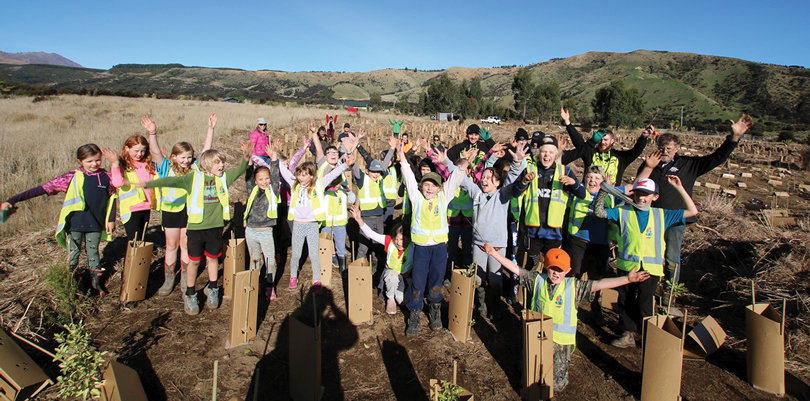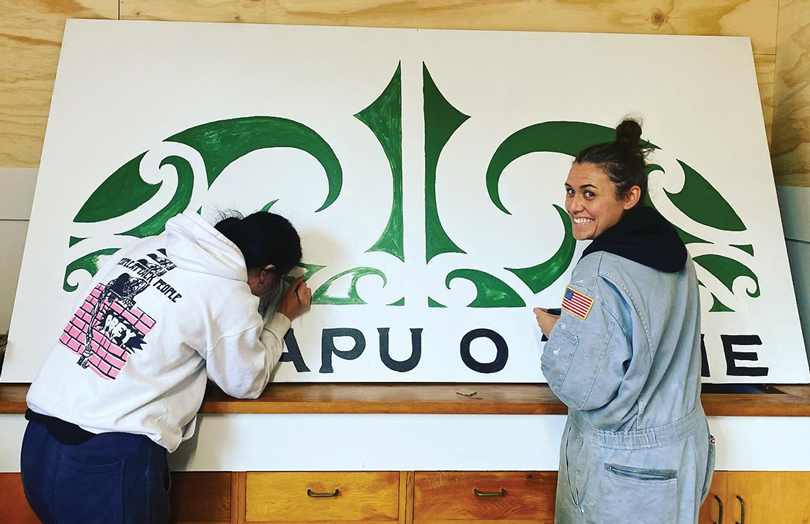Te Tapu o Tāne
Jul 21, 2022

In the heart of Murihiku, four papatipu rūnaka have come together to establish Te Tapu o Tāne, an enterprise founded on the principle of kaitiakitanga – for whānau, and for te taiao. Now in its second year, Te Tapu o Tāne is providing education and employment for rangatahi Māori, and is working with local partners to lead catchment rehabilitation. Anna Brankin reports.

Above: Rangatahi at work planting seeds.
“Te Tapu o Tāne means the sacredness of tāne, and the protection of his forests – his children, his tamariki,” explains Chief Executive Jana Davis (Ngāi Tahu – Ōraka Aparima). “So it’s a very mana-inspiring ingoa and sums up what we are trying to do in terms of looking after our people and our environment.”
The opportunity to be involved with Te Tapu o Tāne came at the perfect time for Jana, whose 20-year career in the oil and gas industry had taken him across the world before he returned home and started thinking about how to do things differently.
“When I moved home a couple of years ago I started reconnecting with Ōraka Aparima, and it all came to a head when tāua passed away,” Jana says. “I realised all these questions that I should have asked when she was alive, but I didn’t, and I started going down some rabbit holes and those rabbit holes helped me understand where I wanted to be headed with my life, which is ultimately advancing mana whenua values and providing pathways.”
Jana’s late tāua, Aunty Jane Davis, was a passionate advocate for the environment, and over her long career she represented Ngāi Tahu on numerous boards, panels and groups. As Jana explored archival footage and articles about Aunty Jane, he began to get a clearer picture about his own direction.
“There was a side of my tāua that I always knew was there but didn’t exactly know, and it was uplifting to discover that I’m aligned with how she thought in terms of caring for the whenua and our freshwater,” Jana says. “On the other hand, it was sad to realise that many of the things she was saying twenty, thirty years ago especially in regards to our environment and freshwater, are still the same.”
“The rūnanga track record for catchment rehabilitation stretches throughout the motu and spans a thousand years. Te mana o te wai, ki uta ki tai – this is so relevant to the Murihiku takiwā, our whakapapa, our identity is all linked to freshwater. I knew we needed something bigger than the volunteer projects I was part of, and I knew that it needed to be done through the rūnanga, from the mountains to the sea, a massive area of interest. And then I found out about Te Tapu o Tāne and I was like ‘this is it, this is an amazing opportunity, I am going to become part of this project’.”
Jana Davis Ngāi Tahu – Ōraka Aparima,
Te Tapu o Tāne Chief Executive
When COVID-19 arrived in Aotearoa, Jana was volunteering in the environmental space in Queenstown. “One of the first things I noticed was the amount of Māori on the ground who were first on the chopping block and, it frustrated me and motivated me to try and create jobs for people, for my people. That was the first calling,” he says. “And around the same time I was seeing a real want from our community to have more iwi engagement, but not knowing how to do it, and I saw the need for a conduit to make that happen.”
As he connected back to the rūnanga, Jana started learning more about the mahi that was already being done in this space. “The rūnanga track record for catchment rehabilitation stretches throughout the motu and spans a thousand years,” he says. “Te mana o te wai, ki uta ki tai – this is so relevant to the Murihiku takiwā, our whakapapa, our identity is all linked to freshwater. I knew we needed something bigger than the volunteer projects I was part of, and I knew that it needed to be done through the rūnanga, from the mountains to the sea, a massive area of interest. And then I found out about Te Tapu o Tāne and I was like ‘this is it, this is an amazing opportunity, I am going to become part of this project’.”

Above: Te Tapu o Tāne CEO, Jana Davis.
The idea began at Hokonui Rūnanga, where Te Tapu o Tāne chair Riki Parata works as a Kaiārahi Taiao, and he started seeing opportunities. “It all started when we saw the kind of demand for native tree species coming out of the RMA reforms and national policy frameworks – trees were needed for riparian plantings, as well as for our own projects,” Riki says. “The One Billion Trees Programme was just kicking off and that’s when we started having conversations about reaching out to the other rūnanga and seeing what we could do collectively.”
To begin, the four runanga – Hokonui, Waihōpai, Awarua and Ōraka Aparima – undertook a feasibility study and began applying for funding under the One Billion Trees Programme delivered by the Ministry for Primary Industries. Things really kicked off when the Department of Conservation released their Jobs for Nature funding in response to the loss of employment created by COVID-19.
“From any crisis comes opportunity, so we partnered up with One Billion Trees and Jobs For Nature, receiving pure capital costs from MPI and pure wage costs from DOC and the size of the project doubled,” Riki says. “Since then it’s grown into a huge landscape restoration kaupapa, all around focusing on Ngāi Tahutanga and strengthening employment with biodiversity outcomes. We want to create a whole package where we go out into the environment, assess the area, grow some trees, do some pest control, teach our kaimahi about reconnection to the whenua.”
Riki says it has been particularly heartening to see how much support is available to the young team of Te Tapu o Tāne. “We’ve been very lucky to have people in the industry who are willing to give their knowledge so freely, and haven’t been scared of another entity starting up,” he says. “They can see what we’re trying to do – that it’s not just another commercial nursery, that we actually have all these social deliverables and we’re not out there to undercut anyone.”

Above: Tamariki from Te Anau kura after a successful tree planting effort.
A key example of this sort of support stemmed from the search for a site for the newly-formed Te Tapu o Tāne.
“Long story short there were a few sites identified but the one that really stood out was owned by Invercargill City Council,” says Riki. “They had an existing nursery structure set up, they were doing a small amount of natives, but most of their operations were focused on annuals and perennials for beautification of the city. So there was an opportunity to share the space and a great opportunity in partnership. This was the direct result of Waihōpai Rūnanga and Awarua Rūnaka who hold mana whenua within the Invercargill City Council district.”
Invercargill City Council Parks and Recreation Manager Caroline Rain says it was a perfect fit. “We had more land than we were using, and the timing was just amazing. It worked so well with what we were wanting to do in terms of a cultural reset of our team,” she says. “The introduction of an iwi partnership at a time that we were trying to make sure we were really well connected – the stars completely aligned on this one.”
Steve Gibling, Leisure and Recreation Manager for Invercargill City Council, says the partnership has the potential to change the way the council does things. “We’ve done something a bit different in the sense that we haven’t just looked at this as a lease agreement in terms of we’ve got a block of land, and you take it,” he says. “We are actually looking for a really strong overlap of operations because that’s where the value sits for us – that we get to rub shoulders with our partner on a daily basis, because that’s where the learning occurs.”
A new type of partnership required a new type of agreement, and Caroline and Jana worked together to draw up a partnership agreement that now sits above the traditional lease and operating agreements. Signed by the council and manawhenua rūnanga Awarua and Waihōpai, it is believed to be unique in Aotearoa.
Te Tapu o Tāne then moved onto the five-hectare site on McIvor Road and began sharing space and resources with existing council staff, who have welcomed the incoming kaimahi and the opportunities for collaboration and knowledge sharing. For Steve, it has been rewarding to see the entity grow in its new home. “To see Te Tapu o Tāne go in such a short time from a concept, to a growing and viable business that is rūnaka-led, that is about enabling rangatahi employment opportunities, we’re so stoked,” he says. “It’s one of those cool stories in which the stars have just aligned and we’re so proud of the team.”

Above: Creating signage for the new premises.
Jana agrees saying, “It feels like everything has just been lining up. So much has happened but it doesn’t feel like it’s been a hard journey because I meet all the right people, every door opens. If I have a question I truly feel like I open the door and the answer’s there. That all has to do with the network supporting this kaupapa.”
The luck continued as Jana built his team, bringing in Chief Operating Officer Ashleigh Taomia, who Jana describes as the dream 2IC. “Ash is a mum, an accountant, and she has lived in Waihōpai her whole life. Ash is tapped into the kura, the kōhanga, and has existing relationships that have brought so much value.”
Next to be appointed was operations lead Phil Moeke, who Jana says “has got this mana about him that I knew people would look up to and respect.”
These roles all support the growth and development of five rangatahi, and 11 seasonal kaimahi, whose work at Te Tapu o Tāne provides them employment and education pathways as well as the opportunity to reconnect to te taiao. A 12-month mahika kai pilot programme is also getting underway, supported by a grant from Te Rourou Vodafone Aotearoa Foundation.
“The students are learning on our time, it’s about four hours a week that they come into the office, they open up their laptops and they get into it,” says Jana. “The goal has been to create a safe place and to acknowledge that it’s OK to have weaknesses. Some of them need extra support with literacy and numeracy, and we provide that.
“We also support them to achieve micro-credentials like chainsaw and 4WD certificates, first aid, Grow Safe. I remember when one of them got his first aid certificate he said to me ‘I’ve never had a certificate before,’ and I said ‘well, you’re about to get a heap more mate!’”
The team has also built a relationship with the Southern Institute of Technology (SIT), with a view to creating an opportunity for the rangatahi to gain qualifications through the work they’re doing at Te Tapu o Tāne.
“We have got confirmation that we can facilitate Environmental Management and Horticulture qualifications, meaning we will be delivering SIT’s content inhouse,” Jana says. “What’s important about that is that the rangatahi will be achieving something through their mahi, and we will be able to put a te ao Māori lens on everything they learn.”
Twenty-two year old Manaia Austin says Te Tapu o Tāne has been a life changer for him, after he relocated from Wellington to connect to his Kāi Tahu, Waitaha and Kāti Māmoe roots, and to spend time with his grandfather.
“It was challenging at first, mainly because trying to connect to the iwi was quite difficult in the sense that I also had to keep working,” Manaia says. “At Te Tapu o Tāne, I get the best of both worlds.”
Most importantly, it’s opened his eyes to a new future. “It has really captivated me, being surrounded by likeminded people, all focused on the same goal, gives me a lot of support to thrive and grow.”
As Te Tapu o Tāne continues to grow, the oversight of the four papatipu rūnanga will ensure it stays true to its founding aspirations, weaving together cultural, social and environmental outcomes.
“As my taua always said, a united approach is the only way because we’re stronger together than apart, and I see this as the four rūnanga coming together for a greater cause: our commitment to the whenua and our waimāori,” says Jana. “Working for an iwi-owned business, I will always have that support behind me – four rūnanga and Te Rūnanga o Ngāi Tahu that I can turn to for guidance, a network of thousands of people and a wealth of knowledge to draw on. Mauriora.”